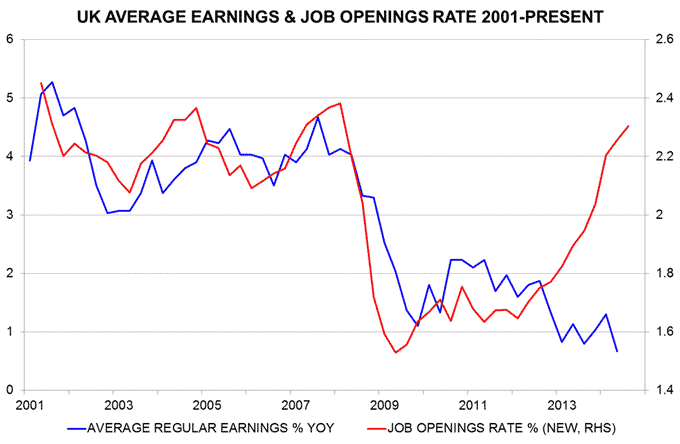UK job openings suggesting early earnings pick-up
The August Inflation Report introduced a new reason for continuing to delay a rise in interest rates – the labour supply, it claimed, has been expanding faster than expected, explaining the recent puzzling combination of strong employment growth with weak wages, while implying still-significant economic slack.
This “theory” is viewed here as implausible, for two reasons. First, it is at odds with official labour force statistics, showing a rise of 0.9% in the three months to July from a year before, equal to the average annual growth rate since 2005. (The Bank's claim may have been influenced by a rise in annual growth to 1.7% in the three months to April, the most recent number when the Report was prepared; this partly reflected a favourable base effect and has since reversed.)
Secondly, a labour supply surge should have slowed the rate of decline of unemployment while helping employers to fill vacancies. The jobless rate, however, has fallen considerably faster over the last six months than during the previous half-year (1.0 versus 0.5 percentage points). The job openings rate (i.e. vacancies expressed as a percentage of filled and unfilled jobs), meanwhile, has continued to rise rapidly and is almost back to its pre-recession peak.
Weak earnings growth probably reflects two factors – problems with the official data and the normal lag between labour market quantities and wages. Surveys paint a stronger picture – the September Markit household finance index, for example, reports the joint-fastest rise in income from employment in its 68-month history. Interestingly, the latest MPC minutes refer to Bank research into the official data suggesting that workforce composition effects “have been pulling down on average wage growth, perhaps significantly”.
The first chart below shows average regular earnings growth and the job openings rate since 2001, when the current vacancies series begins. The relationship over this period suggests that earnings growth should already have risen substantially.
A longer look back, however, indicates that current developments are not so unusual. The second chart shows earnings growth and an earlier version of the job openings rate over 1970-90*. There were three large rises in the openings rate over this period. Earnings growth followed with a lag of between six and 12 quarters.
Returning to the recent past, the openings rate bottomed in 2009 but embarked on a sustained rise only in the second quarter of 2012. Based on the average nine-quarter lag following the three increases over 1970-90, this suggests an upswing in earnings growth starting in the third quarter of 2014.
The lack of movement of wage growth to date, therefore, is consistent with history but a significant pick-up is now likely. With the labour market continuing to tighten, moreover, the coming increase should be sustained into 2016, at least.
*Based on vacancies at Jobcentres.


Reader Comments